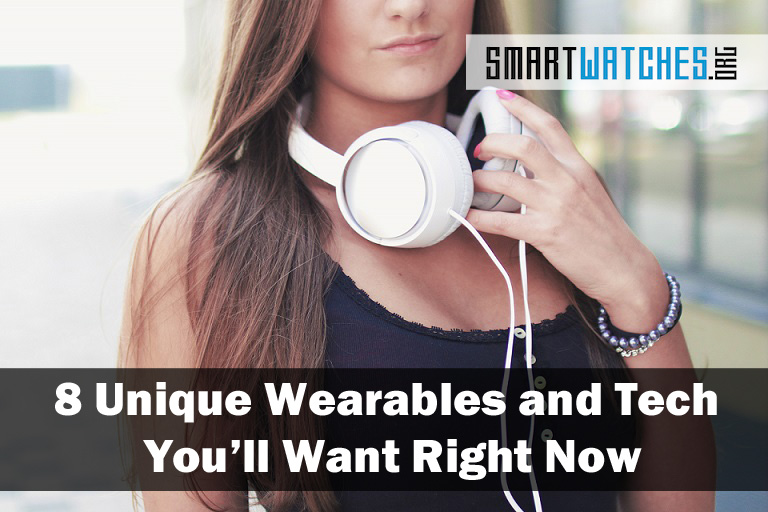Lately, it sure seems like there aren’t many unique wearables because most being released fit into one of two different categories: they’re either a smartwatch or a fitness tracker, or some combination of the two.
There are, of course, other types of wearables but they don’t seem to be the focus, that’s for sure.
We realized that our coverage has grown a bit stale on that front. There are too many of the same “smart” wearables and watches available.
That’s when we started searching for some truly interesting, unique wearables that offer a different experience than most.
We’re not just talking about wearables that do the same things in new ways. We’re talking about something truly amazing; like wearable clothing that has the necessary components woven into the fabric, or augmented reality tech that projects images and scenery into the open air.
8 Unique Wearables and Tech You’ll Want Right Now
For all intents and purposes, this is the stuff that will help advance the whole of the technology market – and not just the wearable one.
We hunted down a few of these unique wearables and we’re going to share them with you now.
Elemoon
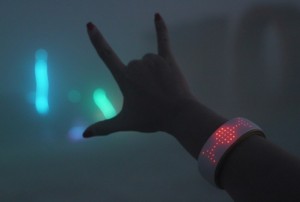 At first glance, the Elemoon doesn’t look much different than anything else we’ve covered. In fact, it actually looks like a piece of jewelry, which is more than okay.
At first glance, the Elemoon doesn’t look much different than anything else we’ve covered. In fact, it actually looks like a piece of jewelry, which is more than okay.
What makes the Elemoon part of the unique wearables crowd is that it’s packed with a variety of LED lights, which can be used to display different colors or patterns. Through a smartphone app, you can customize the colors so that they match your outfit, or set the bracelet on a mode so that it mirrors your mood – like a mood ring.
The Elemoon is “smart” and can show calls and notifications, track activity levels and steps, and find your phone if it’s lost. It can even display the time like a watch.
Why we added it to the list, however, is because the incredible array of LEDs allow a layer of personalization, unlike anything we’ve seen in other wearables.
Not to mention, when powered off, this thing is one hell of a fashion accessory. It seems that a lot of wearables go the opposite route and end up looking ugly, geeky, or downright unbearable at times.
Simply put, the Elemoon is one of the most remarkably unique wearables out there, at least for now.
Kokoon EEG Headphones
 Kokoon is a pair of headphones, that you could theoretically wear every day if you wanted. The developers partnered with ONKYO to ensure the headphones will deliver “truly world class audio” to wearers.
Kokoon is a pair of headphones, that you could theoretically wear every day if you wanted. The developers partnered with ONKYO to ensure the headphones will deliver “truly world class audio” to wearers.
Of course, it wouldn’t be on the list if that’s all it was. The real reason the Kokoon EEG headphones are unique is because they are meant to be worn while you sleep. They are designed to cancel out surrounding noise from the environment, and playback soothing sounds and tracks to help you sleep better. All the while, the headphones will measure your sleep patterns, acting accordingly when you enter a light sleep or a deep one.
In addition, they will help you wake up at a more natural point in your sleep cycle, which should translate to you feeling much more refreshed in the morning.
All data is tracked via a mobile app, synced through Bluetooth 4.0, which lets you know how well you slept the night before. In addition, the app will learn what helps you sleep better and ensure the headphones are using said methods to improve your rest.
If you’re wondering whether or not they are comfortable – after all they’re meant to be worn in bed all night long – the answer is, apparently so. The design takes advantage of specifications like the “cool comfort system” which should ensure you’re not sweating like crazy while wearing the headset.
Sadly, the headphones aren’t scheduled to start shipping to backers until later in 2016 – they were originally funded on Kickstarter. That’s around the time they should go into mass production, as well.
The Kokoon EEG headphones definitely belong in the unique wearables brigade, that’s for sure.
Project Jacquard
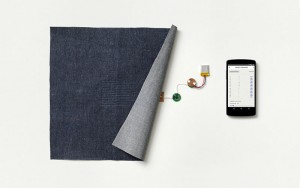 Designed by Google’s Advanced Technology and Projects (ATAP) team, Project Jacquard is a push to take wearables, electronics, and various components and embed them in fabrics.
Designed by Google’s Advanced Technology and Projects (ATAP) team, Project Jacquard is a push to take wearables, electronics, and various components and embed them in fabrics.
Ultimately, this will allow creators to put together clothing and textile components that have electronics and interactive tools built-in, yet you would never know the difference when comparing them to regular fabrics.
At the project’s core is a fabric called Jacquard yarn that is conductive. It’s made of the same basic materials as regular yarn and looks similar. The only difference is that the conductivity allows electrical signals to be passed through it, just like an electrical circuit board.
What does all this mean? What can the Jacquard yarn be used to create?
Imagine a jacket or pair of jeans that will allow you to control your smartphone, TV, or media device by simply interacting with the clothing. There would be no need to take your phone out of your pocket, hunt down a remote, or search for controllers; at least not for simple tasks.
There are so many things you could do with technology like this. You could send messages to friends and family, silence incoming calls or notifications, change the channel on your television or raise the volume, turn on – or off – smart lights positioned throughout your home, and much more. And all of this can be done, by simply interacting with the fabric of the clothes you are wearing.
Perhaps most surprising is the fact that we won’t have to wait long to see it in action. Renowned denim maker Levi’s is working on a pair of jeans that incorporates this tech, and they expect to launch sometime this year (2016).
Verily
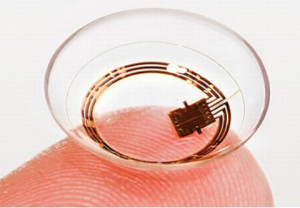 The first thing to mention about Verily is that they are a company, not a single product. The reason they are on the list is because they develop hardware that bridges the gap between technology, and humans. If that sounds ambitious, it’s because it is.
The first thing to mention about Verily is that they are a company, not a single product. The reason they are on the list is because they develop hardware that bridges the gap between technology, and humans. If that sounds ambitious, it’s because it is.
The reason they are on the list is because they develop hardware that bridges the gap between technology and humans. If that sounds ambitious, it’s because it is.
They aim to create devices that can monitor the human body, health, and anything related to those things so that we – as a species – can react preventatively and proactively – instead of reactively.
For instance, most healthcare plans involve taking care of patients after a diagnosis is made. Wouldn’t it be smarter to prevent these things before they happen?
That’s exactly what the folks at Verily are trying to do.
One of the first pieces of technology they are working on – which serves as a great example of their prowess – is a contact lens that includes an embedded glucose sensor. This technology will allow those with diabetes to continuously monitor their glucose levels, by measuring the contents of their tears. The lenses will offer continuous, non-stop monitoring – which is safer – and this measuring tool is less painful than what most diabetics use now.
Of course, the contact lenses are just the first creation from this incredibly talented team.
We can’t wait to see what other unique wearables they come up with in the future.
Magic Leap
 Magic Leap’s technology is difficult to pin-down considering they have yet to unveil an official product. That said, what’s been described is extremely promising.
Magic Leap’s technology is difficult to pin-down considering they have yet to unveil an official product. That said, what’s been described is extremely promising.
Reported to be developing a “cinematic reality” device, Magic Leap has raised $793.5 million for funding in one of the biggest “C” rounds in investing history. A startup raising that much is virtually unheard of.
Why were they able to do this?
Purportedly, the company is working on augmented reality tech that will see virtual – or digital – elements projected into the physical space. Imagine, fish from an underwater movie scene swimming in the air in front of your TV.
It’s not meant to be used for one specific entertainment purpose either; meaning when the company finally launches their technology we should see games, movies, and more compatible with it.
If you want to know more, just go fiddle around on the official company’s site. Seriously, it’s some pretty impressive stuff. We can’t wait to see what technology they’re going to come up with, especially if it fits in the unique wearables category.
Quell
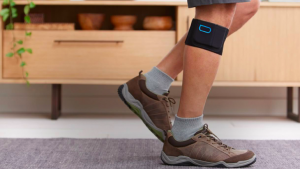 Want an example of tech being used for more practical means, Quell is one of the truly unique wearables that offers “100% drug-free, pain relief”.
Want an example of tech being used for more practical means, Quell is one of the truly unique wearables that offers “100% drug-free, pain relief”.
The Quell is a small device that is worn using a brace, positioned just below the knee.
If you suffer from chronic pain, you can simply tap the button to activate it, and relief is instant. How does it work?
Quell uses nerve stimulation to tap into your body’s natural pain system in order to block pain signals that you would otherwise receive. According to the company, it’s been cleared by the FDA for 24/7 use, during the day and night. They also claim that it works so well, 67% of users have reported a reduction in their use of pain medication.
It’s not meant to take away the pain completely, but instead, make it manageable so that the quality of life is improved for those suffering from extreme amounts.
It includes an app which seems to be a central hub for using Quell, by offering quick-use tutorials and guides.
Users have reported that the device lasts for several days on a single charge, and does, in fact, take away their pain. Although, levels of relief will vary from patient to patient.
The Quell does use replaceable electrodes, which will need to be stocked up if you plan on using it for an extended period of time. The starter kit comes with a month supply, you can purchase more separately.
FingerIO
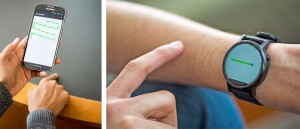 What if you could turn virtually any surface into an extension of your touchscreen? We’re talking about using your skin, your clothes, the table, or anything you can think of as an interactive surface.
What if you could turn virtually any surface into an extension of your touchscreen? We’re talking about using your skin, your clothes, the table, or anything you can think of as an interactive surface.
FingerIO uses an active sonar system to turn surfaces into a control peripheral. For instance, to compose a text you can trace letters on the surface of a table next to a smartwatch. It will pick up your movements and translate them into text.
FingerIO’s tech can turn anything from a smartphone to a smartwatch into a universal sonar device.
You don’t have to wear anything special to take advantage of the technology, either. The speakers of the device emit inaudible sounds which bounce off nearby surfaces and is then picked up by a microphone. Through software modulation, the accuracy of this system can be improved to translate those movements into credible actions – like swipes on a touchscreen.
You can swipe, tap or trace outlines on a nearby surface to interact with a connected smart device.
Naturally, technology like this could lead to frequent mistakes because the system might also register unwanted interactions when you move a finger or a hand. To prevent this, FingerIO employs an activation gesture – a double swipe carried out within five centimeters of the connected device.
It will be a while before this technology is available to consumers, but it’s definitely promising.
We can’t wait to interact with our unique wearables in new and interesting ways!
Empatica Embrace
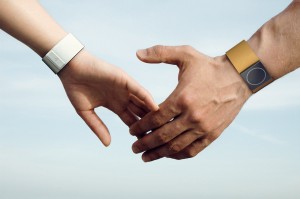 The Empatica Embrace is in our list of unique wearables because it is designed to help those who suffer from epilepsy.
The Empatica Embrace is in our list of unique wearables because it is designed to help those who suffer from epilepsy.
Through a variety of data tracking features, Embrace will help epileptics understand their body patterns. Hopefully, this will allow them to predict when a seizure is coming so they can at least prepare.
The Embrace monitors seizures and patterns that go along with them, stress and physiological patterns, sleeping habits and activity levels.
All notifications are delivered directly to the wearer’s wrist.
The Embrace is thin, slick looking, and includes integrated medical grade technology. It’s amazing to see something as simple as a smartwatch-like device, being used to improve the quality of life for others.
Make no mistake about it, this is the future of wearable technology.

